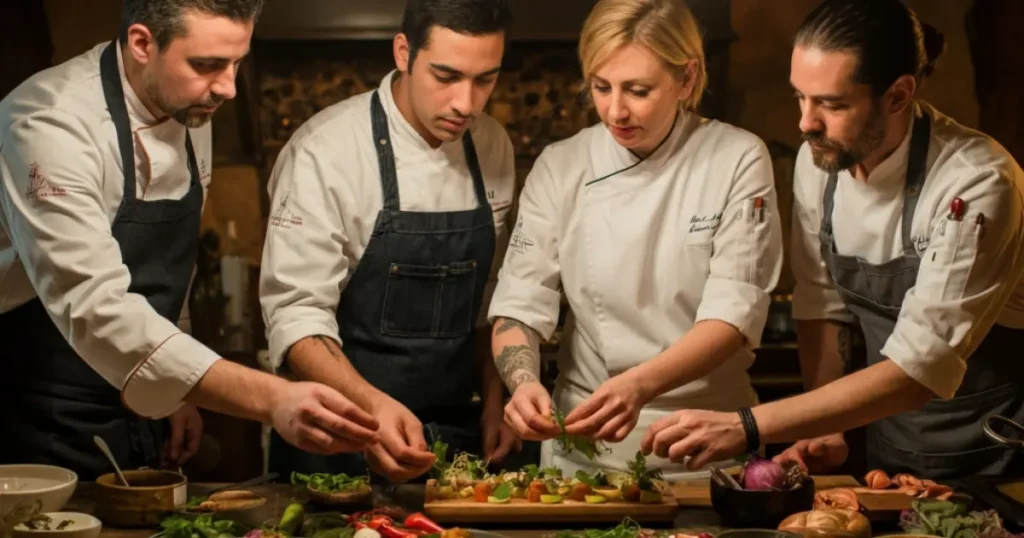What if one dish could bring together the essence of a meal, showcasing creativity, skill, and an unforgettable dining experience? This is the magic of “Reunion 1 Course 4,” a culinary concept making waves in fine dining and inspiring chefs to redefine what it means to cook with intention.
Both indulgent and innovative, Reunion 1 Course 4 represents the harmony between thoughtful ingredient selection, advanced techniques, imaginative concepts, and visually striking presentation. Whether you’re a seasoned chef, a home cook on a mission to improve, or a devoted foodie eager to explore the world of gastronomy, this guide will break down everything you need to know about it.
What is Reunion 1 Course 4?
At its core, Reunion 1 Course 4 refers to a pivotal course within a carefully structured multi-course meal. Originating from the concept of culinary storytelling, where each dish builds upon the last, this fourth course is often considered a moment of reconnection. Chefs use this course to highlight innovation, creativity, and their unique culinary voice while reaffirming the meal’s theme.
Think of it like the “climax” of a meal. Following an appetizer, soup/salad offering, and smaller entrée, the fourth course is where chefs strike a perfect balance of flavor, technique, and artistry.
The term “Reunion” symbolizes the meeting of exceptional ingredients, harmonious flavors, and skilled techniques. It’s about bringing everything together, whether you’re crafting this in your restaurant kitchen or cooking for loved ones at home.
Globally embraced by experimental chefs and adored by foodies, this concept emphasizes not just what’s on the plate but the intention behind it.
Key Elements of Reunion 1 Course 4
Just as an orchestra thrives on coordination among instruments, the success of a Reunion 1 Course 4 dish relies on mastering several key elements.
Ingredient Selection
No dish can shine without the right ingredients. For Reunion 1 Course 4, freshness and seasonality are paramount. The fourth course usually uses hero ingredients that are either seasonal highlights or locally sourced favorites that carry the story of the place or culture where they are served.
- Seasonal and Local Produce: Think of late-summer heirloom tomatoes drizzled with olive oil or winter’s finest black truffles as the dish’s centerpiece.
- High-quality Proteins: Whether it’s sustainably raised fish, dry-aged beef, or delicate duck breast, quality always comes first.
- Unexpected Flavor Pairings: Use ingredients that contrast or complement one another to keep the diner curious. Sweet and salty or umami and tangy combinations keep the taste buds engaged.
Techniques and Skills
A successful fourth course demands advanced culinary techniques executed flawlessly. The dish often incorporates cooking methods that elevate flavors and textures. Examples include sous vide for precise temperature control, confit for tender results, or deglazing for rich sauces.
- Multi-layered Cooking: Hand-rolled pastas paired with rich reductions, or proteins cooked with dual techniques (like searing and braising) add complexity.
- Finishing Techniques: A final flourish, whether through torching crème brûlée-like toppings or adding edible smoke, creates a lasting impression.
Creativity and Innovation
Reunion 1 Course 4 is an opportunity for chefs to show courage and creativity in their culinary narrative. This is where “thinking outside the box” comes into play.
- Unexpected Twists: Transform ordinary ingredients into extraordinary presentations, such as turning a classic pumpkin into an airy mousse alongside spiced candied nuts.
- Cultural Inspiration: Infuse global touches, like using miso caramel in dessert sauces or adding harissa to savory items, paying homage to different cuisines.
- Storytelling: Beyond the plate lies the dish’s story. Each aspect—from color to structure and flavor balance—should contribute to the theme of the menu as a whole.
Presentation and Plating
The saying “you eat with your eyes first” has become more relevant than ever, especially in the era of Instagram. For the fourth course, plating is as vital as the ingredients themselves. Bold yet clean designs make the dish memorable.
- Layering Elements: Incorporate thoughtful layering that creates height or depth on the plate.
- Balance: Ensure the presentation reflects balanced proportions between the protein, vegetable, and sauce.
- Garnishing: Use microgreens, edible flowers, and powdered dustings as finishing touches to elevate your plating.
Benefits of Understanding Reunion 1 Course 4
Understanding and mastering Reunion 1 Course 4 can elevate your craft to the next level, whether you’re a professional chef or an ambitious home cook.
Enhanced Culinary Skills
This concept allows chefs to experiment with techniques, ingredients, and flavor profiles, enabling them to grow their repertoire while also perfecting their focus.
Improved Menu Planning
By understanding the structure and purpose of each dish in a multi-course meal, chefs can design menus that flow cohesively, ensuring complimentary transitions from course to course.
A Greater Appreciation for Food
For foodies, learning about Reunion 1 Course 4 can deepen their appreciation for flavor, presentation, and intention. The knowledge transforms dining into an immersive experience.
Celebrating Successful Reunion 1 Course 4 Menus
NOMA (Denmark)
René Redzepi has masterfully created fourth courses emphasizing foraged ingredients, such as lamb with spruce and bee pollen sauce.
Atelier Crenn (San Francisco)
Dominique Crenn brings poetry to her plates, inspiring dishes like spring pea risotto served with edible blooms in her tasting menus.
Gaggan (Bangkok)
Gaggan Anand builds creative, playful fourth courses, like yogurt explosions over vibrant Indian masala powders, with bold interactive twists.
Tips for Creating Your Own Reunion 1 Course 4 Menu
- Start with Ingredients: Visit your local farmer’s market or supplier to identify inspiring seasonal options.
- Experiment with Methods: Push boundaries by pairing different cooking processes (e.g., roasting + pickling).
- Test Plating Beforehand: Practice various plate arrangements to see what looks visually appealing before presentation.
- Get Feedback: Share trial dishes with friends or family for honest opinions on flavor and presentation.
Elevate Your Culinary Game
Reunion 1 Course 4 is more than just one chapter of a meal; it’s a chance to showcase skill, vision, and artistry. Whether you’re cooking on the line in a top-notch restaurant or perfecting your craft at home, every stage of preparation can drive your excellence forward.
Why not start experimenting? Harness your passion, and bring an unforgettable fourth course to life.







